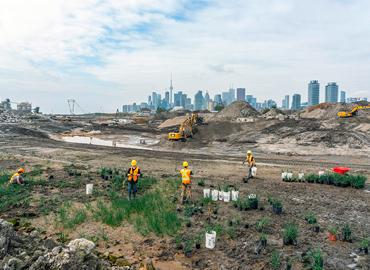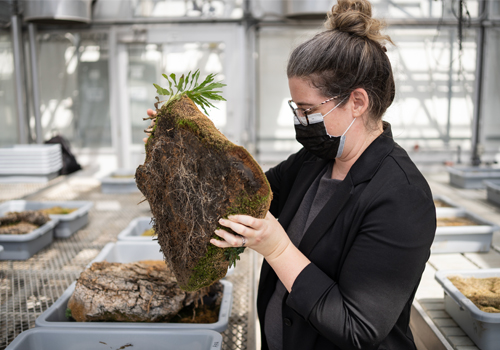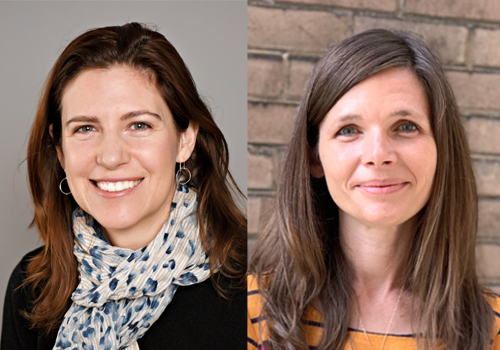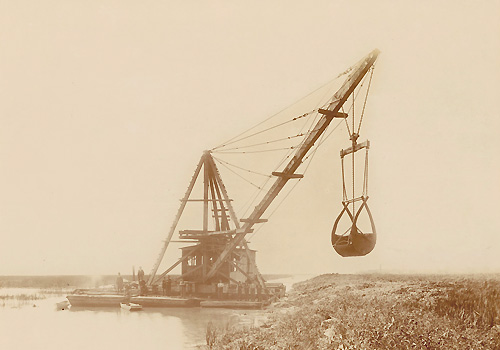U of T researchers studying an ecological time capsule from Toronto Port Lands excavation site
In early 2021, keen-eyed workers at a Toronto Port Lands construction site on the city’s waterfront spotted plants that had sprouted from soil recently exposed by the removal of tons of earth. The plants were hard stem bulrush and cattails which are commonly found in freshwater marshes.

Because the patch of ground from which they grew had been seven metres below the surface for a century, conservationists concluded that the plants had grown from seeds buried when Ashbridges Bay Marsh at the mouth of the Don River was covered with landfill in the early 1900s.
Now, a team of U of T researchers including Sarah Finkelstein and Shelby Riskin is studying the soil removed from the site for a better understanding of the long-lost natural habitat.
Paleoecologist Finkelstein is an associate professor and chair of the Faculty of Arts & Science’s Department of Earth Sciences. She studies paleoenvironmental records to better understand past climates and how ecosystems respond to environmental change. Undergraduate geography student and University College member Mrinmayee Sengupta will be helping her in the analysis of the Port Lands soil.

Ecosystem ecologist Riskin is an assistant professor, teaching stream, in the Faculty of Arts & Science’s Department of Ecology & Evolutionary Biology (EEB). She studies how changes in land use impact ecosystems and how those ecosystems can continue to function in the face of change. Undergraduate environmental science student and Victoria College member Stuart Ralston will be working with Riskin on the project.
According to Finkelstein, “Our first goal is to understand what the marsh looked like back then. We’ll try to answer questions like: What was the plant community like? What were the food webs like? What role did this marsh play ecologically on a local and regional scale?”

Says Riskin, “We’ll look for evidence of the life in the marsh — shells, seeds, pollen — and hopefully get an idea of the biodiversity of those soils from a hundred years ago and compare it to what we find in the wetland soils in the area today.
“I’m quite curious as to what we will find,” she says. “If there is going to be a viable seed bank of native plants in those soils or if there’s evidence that it was already a degraded ecosystem a hundred years ago.”
While Ashbridges Bay Marsh had been a thriving natural ecosystem, by the end of the 1800s, it was suffering from sewage and pollution from — among other sources — Toronto’s waterfront cattle yards. Then, as the city grew in the early 1900s, it was covered over and more industry moved onto the new land.
Today, the Port Lands is undergoing major redevelopment to reduce flooding at the mouth of the Don River and to create parks and new wetlands. As workers dig, they are uncovering the city’s recent history like urban archeologists.
The researchers will also measure the carbon content of the soil to understand whether it came from a natural source or human activity, and how well the marsh served to absorb and store carbon.

“Right now, my research group is working a lot on carbon uptake and sequestration in wetlands which is an important research focus in Ontario given our abundance of wetlands and their potential role in mitigating climate change,” says Finkelstein. “This work could tell us how well this wetland functioned as a carbon sink. It will also help us learn more about wetland restoration and what we may be able to recreate on the Toronto waterfront.”
Along with their analysis, horticulturalist Tom Gludovacz and Melanie Sifton are caring for soil retrieved from the site from which bulrush, cattails and a variety of moss-like plants have already germinated.
Gludovacz is with EEB and the Faculty’s Department of Cell & Systems Biology, and Sifton is a PhD candidate in the Institute of Forestry & Conservation in the John H. Daniels Faculty of Architecture, Landscape, and Design.
“This project is super exciting,” says Riskin. “Not only will it inform the current restoration and renaturalization of the waterfront, but it will also tell us about Toronto as it was a century ago.”
Says Finkelstein, “It’s a really exciting moment for Toronto. It’s a great story about the resilience of nature in the city and it’s great for inspiring people to maintain a connection with nature.”
